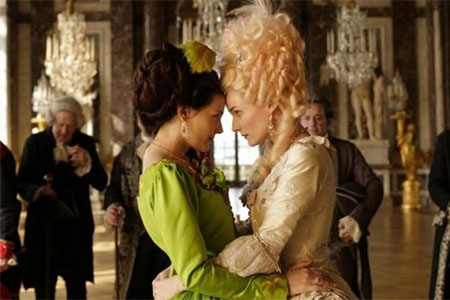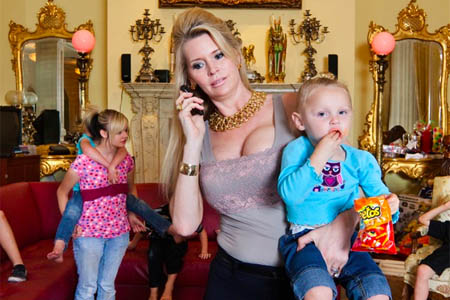By Jonathan Marlow, Glen Helfand, Susan Gerhard and Lynn Rapoport
On opening night, the 55th San Francisco International had a need to celebrate almost as strong as its need to mourn the two deceased San Francisco Film Society executive directors of 2012. Somehow, it limned both ends of the emotional spectrum with a tribute to Graham Leggat via a screening of Benoît Jacquot‘s Farewell, My Queen. (Bingham Ray’s tribute comes via a screening of The Third Man April 28). Jacquot’s film, also the Berlinale opener back in February, combined intimate scandal, the expected sumptuous costuming, and righteous revolution to create a strong sense of occasion that spoke to the idea of “transformation” Leggat reflected upon often in his final year. Though it was an evening of remembrance, the mood was lively: Presenting his film, Jacquot flattered the San Francisco audience with praise for its intelligence and discerning taste. “I don’t want to show this film to just anybody.” Nearly a week into the 14-day festival, a Keyframe reporting team writes on a few other key moments of fest-going. (Susan Gerhard)
Editor’s note: Celebrate Fandor filmmakers in the 2012 San Francisco International Film Festival Thursday, April 26, 8-10 pm at Public Works, 161 Erie St, SF.
Jonathan Lethem: The State We Are In
Framed within the notion of plate-spinning from which to structure seven disparate themes, author Jonathan Lethem delivered the latest edition of SFIFF’s State of Cinema address with expected aplomb. At the onset, festival programmer Sean Uyehara noted in his introduction that this was the tenth in a series. I had mistakenly imagined the number as half the size. Regardless, Lethem was an ideal choice, particularly in the wake of a fumbled effort last time around (or so I’ve been told by noted bon vivant Meredith Brody and others in attendance the previous year; I was away at Tribeca, the concurrent festival on the opposite coast, for a speaking engagement of my own).
Watch Jonathan Lethem: State of Cinema Address from the San Francisco Film Society here via Vimeo.
What of these figurative plates Lethem opted to verbally spin for our enjoyment? The course careened from topics (mumblecore to the Occupy movement to neoteny) to concepts (“cinema has no present” or “the true versus the real” or “sponge listening versus obedient listening”). Among the insights, paraphrased… (1) The welcoming of cinema to the realm of the undead, laying waste to the preposterous notion that whatever is new will decimate the old. (2) A proposal that growth in the arts tends to follow a pathway of pedomorphism, wherein “mature” forms retain traits from their own infancy. (3) An urge for so-called mumblecore filmmakers to buy a tripod (“they’re not that expensive”). (4) An acknowledgement that we’re at a point (with cinema) that we’re far enough out to sea that we can no longer see the shore. (5) Relative to the other arts, an admission that cinema is merely the equivalent of a four-year-old child.
There were other ideas. Many others. Out of context, these don’t quite have the same ring to them. But this should give you a general grasp of the State we’re in. Until next year, at least. (Jonathan Marlow)
Acid Queens: Peaches & Tommy
The oversized teased and bleached blonde wig of San Francisco’s most cineastic drag queen, Peaches Christ, is ultimately no match for the expansive, acid-fueled imagination of Ken Russell, who died last year. As is always the case with Peaches’ Midnight Mass events, which was born in the aging Bridge Theatre, this one was built around a single film, Russell’s 1975 film version of Tommy—and billed as a tribute to its director. The Kabuki’s main auditorium stage held a rock’n’roll band’s equipment, and a giant Mardi Gras-style Peaches head. Peaches, a surprisingly good natured drag queen/film buff, sang “Pinball Wizard” decently, and introduced friends with more powerful voices to perform “Acid Queen.” But something about this theater seemed a little too clean and corporate to have the expectant, sticky floor stoner vibe of, say, a Rocky Horror in its heyday. “How many of you are on acid?” Peaches asked the crowd. There were murmurs of response, but no collective sense of ebullient hallucination.
A well-composed reel of film clip, however, took care of that. Russell’s work is visually abundant—though not much of it easily available. Roger Daltry’s giant phallus in Lisztomania (1975) looked to be the kind of folly that movies are made for, as did a production number from Busby Berkeley nod, The Boy Friend (1971), which starred the ’60s supermodel Twiggy (a testament to Russell’s interest in actors from other pop fields), and The Lair of the White Worm (1988), appeared to be rich and strange, complete with absinthian cocktails. Visually, Tommy held up (even if the Who’s plot lines were earnestly puerile)—gliding from one musical set piece to the next, from pinball wizardry to Tina Turner’s power lips and shivering thighs. And nothing beats large screen visions of Ann-Margret sploshing with baked beans and chocolate sauce. (Glen Helfand)
Let Them Eat Cake
There are those whose advice for satisfying festival film-going is to stick with docs, a philosophy that definitely pans out with Lauren Greenfield’s timely investigation of the American psyche and economy. The Queen of Versailles is a visually crisp—its evident its maker is a photographer—and manages to be both an entertaining and hard look at this country’s values and aspirations. The queen of the title is 40-something, surgically augmented Jackie Siegel, who along with her time-share mogul husband, the 30 years her senior David, are, at the film’s start, building the world’s largest home in Florida. The 90,000 square-foot edifice is akin to a big box store filtered through the titular French palace. Images of excess and a taste for the gilded make for comical moments that bring up complicated questions about exploitation, but it’s not long before the inevitable crash occurs, and the imagery shifts from glittering baubles and luxury goods to carpets littered with dog poop.
Greenfield herself struck gold with this story, catching its two compelling lead subjects whose sense of narcissism and obliviousness (“Who is my driver?” asks Jackie when she must switch to consumer grade rental cars) is tempered by a curious humanity and familiar dysfunction. In the Q&A, Greenfield described Jackie as a tough cookie, a term that could be applied to her husband, both of whom came from working class backgrounds. The audience seemed to have more concern for their eight children, whose educational future wasn’t built into the financial plan. Greenfield described the patriarch as an optimist who figured time sharing as a ever growing business. The conversations about the film’s issues most certainly continued over artisanal cocktails at nearby nightspots. (GH)
Visually, ‘Tommy’ held up (even if the Who’s plot lines were earnestly puerile)—gliding from one musical set piece to the next, from pinball wizardry to Tina Turner’s power lips and shivering thighs. And nothing beats large screen visions of Ann-Margret sploshing with baked beans and chocolate sauce.
The Art of Greek Unease
Viewers familiar with Greek screenwriter-director Yorgos Lanthimos’s 2009 black comedy Dogtooth may have been sufficiently prepped to composedly sit through the disjointed episodes of his most recent film, Alps. Or maybe not—people exiting the theater at the April 21 screening generally had a shell-shocked appearance, as if they’d been witness to a long, strange catastrophe, or perhaps a film about a group of people acting under the influence of extremely misguided inspiration. Related by premise to our dealings with death but spreading its mournfulness more broadly over the continuum of human emotional activity, Alps concerns an earnest and odd quartet—a hospital nurse (Aggeliki Papoulia) living with her elderly father, her paramedic coworker (Aris Servetalis), a young rhythmic gymnast (Ariane Labed), and her coach (Johnny Vekris)—in pursuit of a shadow career offering succor to the bereft in the form of awkward substitutions for their recently deceased loved ones. This seems like a disastrous, monumentally uncomforting service, and providing it certainly takes its toll on Papoulia’s character, whose mental disintegration is the central arc of the film. But the clients participate in the clumsy restagings of familial encounters with a flat, mechanical, nearly wordless acceptance that makes the transactions feel creepily one-sided, psychically unbalanced, even during scenes of unsettling intimacy. And all of this unfolds in a mode that feels absurdly comical, or at least provokes uneasy laughter, until it really, really doesn’t and the house goes silent and the audience trudges out wondering what terrible thing just happened. (Lynn Rapoport)
Tag Teams
After the small programming hiccup of a fire alarm cleared the Sundance Kabuki Cinemas of festivalgoers for half an hour or so on Sunday, April 22, attendees filed back into two packed screening rooms for David France’s How to Survive a Plague. The longtime print journalist’s exceptionally researched first foray into documentary filmmaking depicts the unflagging efforts (from direct actions to underground drug trials and buyers’ clubs) of a handful of AIDS activists in New York City during the 1980s and early ’90s. Forming the organizations ACT UP (AIDS Coalition to Unleash Power) and later TAG (Treatment Action Group), Housing Works, and others, Peter Staley, Bob Rafsky, Mark Harrington, and thousands more battled the disease as well as the Reagan and Bush I administrations, the NIH, Big Pharma, and other entities seemingly uninterested in dedicating serious, credible resources to the containment of a terrifying epidemic. In the course of making the film, France amassed a staggering quantity of archival material—in the Q&A following Sunday’s screening, he remarked on the simultaneous appearances of AIDS and the camcorder and described a process of poring through footage, identifying activists in the crowd who were themselves recording events, tracking them (or often their survivors) down, in some cases nearly a quarter century later, and amassing still more visual evidence of a historic and transformative battle. We see the film’s subjects fighting for, and living, their lives. And every so often, as the years pass, we see a new, increasingly appalling figure in the ongoing tally of AIDS-related deaths worldwide, as if to underscore the reality that this is how to survive a plague here, while the strategy on a global scale remains an open question. (LR)





